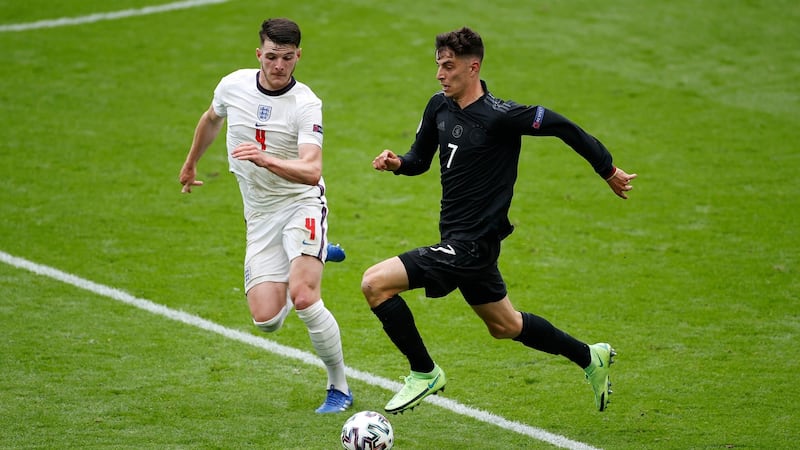Inevitably, it would be the attackers who grabbed the headlines. Amid the uncorked pandemonium of England’s 2-0 win against Germany on Tuesday, perhaps it was only natural that the defining motifs would be of England’s two goalscorers. The gnarled, gritted features of Harry Kane, staring out from Wednesday morning’s front pages like a king restored to his throne. The stern thousand-yard stare of Raheem Sterling adorning a thousand memes and highlights reels, daring you to doubt him ever again.
But perhaps the most interesting element of England’s night of jubilee at Wembley was that on first glance it didn’t appear to have an obvious architect. Above all, England’s win was a very collegiate sort of triumph, studded with fine performances and nervelessly mapped out by Gareth Southgate. Yet to single out individuals is really to miss the essence of what made England so effective.
In a game that was even for much of its length, England’s collective command of territory and space was ultimately the decisive factor. It may not scan neatly into a headline. You are highly unlikely to ever encounter the words “England’s coordinated midfield counter-press and fluid, intelligent off-ball movement. That’s it. That’s the tweet.” But really, this was a game won and lost in the middle.
Existential sickness
Even to type these words is to sketch out an unnerving parallel reality. For a decade, perhaps more, England’s midfield has been a sort of existential sickness, a perennial inferiority complex, a reminder of its diminished place in the world. France have N’Golo Kanté and Paul Pogba. Belgium have Kevin De Bruyne. Spain have everyone else. England, by contrast, have perennially treated their midfield like an unexplained stain on the trousers: don’t mention it, and just maybe no one will notice.

England notionally have Declan Rice and Kalvin Phillips in midfield, and both have had excellent tournaments. Both were supreme on Tuesday: Rice in his positional sense and frugal use of the ball, Phillips in his ability to disrupt play and get attacks moving. But the real breakthrough this tournament has been less about individual personnel and more about tactics and movement.
We are often conditioned in this country to think of the midfield as a discrete unit of labour. But in the more fluid modern game, where formations and positions hold decreasing relevance, it helps rather to think of it as a zone of control that any outfield player can influence. Or, more simply, your midfield is not simply your midfielders. Perhaps this is best illustrated by splitting the Germany game into its four distinct phases.
In the first phase, Germany are rampant. England lose the ball in midfield four times in the first seven minutes. But the fault lies not with Rice and Phillips. Pretty much every time England get into trouble, it is because Luke Shaw and Kieran Trippier – neither a natural wing-back – have reverted to their natural tendency to drop into line, essentially creating a flat back five with acres of space between the lines. A massacre beckons.
Implied threat
The second phase begins on 12 minutes when Sterling drops into midfield to gather a long throw, turns and runs. Instantly you can see Germany flooding back to deal with the implied threat. This is what Southgate meant when he spoke later of the “jeopardy” that Sterling and Bukayo Saka can create: by running at teams from midfield they force them to sit deeper and cede space. For the first time Rice and Phillips have time and space to play. Harry Maguire steps up. The wing-backs can advance safely in support. England now no longer have two midfielders but six or seven. Before the long throw, Germany have had 67 per cent possession and both shots. Between 12 and 30 minutes, England have 64 per cent possession and all three shots.
The third phase of the game lasts from 30 to 68 minutes. It is bitty, broken, tough to watch. There are big chances at either end. Kane and Trippier spend time getting treatment. England have gained control of the territorial battle but are not bending Germany out of shape. Sterling and Saka are England’s only attacking threats, and Germany know it. In the third phase, which ends when both teams make their first change, Germany have 55 per cent possession and all three shots.

The introduction of Jack Grealish, with Germany beginning to tire, decisively shifts the game. Kyle Walker steps up beyond a flagging Müller and takes up increasingly central positions. Sterling plays higher, almost as a second striker. Grealish, meanwhile, goes pretty much where he wants. As well as offering fresh pressing legs, he has the licence to drop deep into midfield, and neither Matthias Ginter nor Joshua Kimmich ever really works out who should be tracking him.
And so with 15 minutes left, Grealish tucks in and Kimmich follows him, leaving Shaw unguarded on the opposite flank. By the time the ball has been worked around to Sterling, Antonio Rüdiger has pushed up, Müller and Toni Kroos have been sucked in, and at the moment Grealish releases the ball to Shaw every single German is in a narrow band around the width of the six-yard box. Sterling scores. Finally England’s quirky, unpredictable movement has forced Germany to collapse in on themselves.
Germany never get their shape back after that. As a measure of England’s dominance of the central areas, Kroos ends with a pass completion percentage of 82.1 per cent, his fifth-lowest for club and country over a full 90 minutes since the start of 2017-18. Or, put another way: England restricted one of the world’s best midfielders to the sort of performance he only records about once a season on average.
This is why England now stand only three matches away from glory. But here is the irony: had Müller converted his late one-on-one chance before Kane made it 2-0, it might all have been for nothing. This is the tightrope of international football: a game of fine margins and razor edges. For now, happily, England are catching the right sort of breaks. – Guardian











